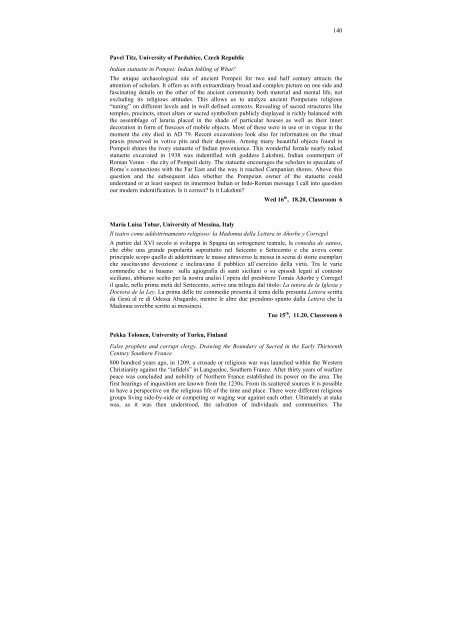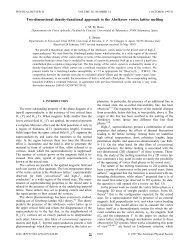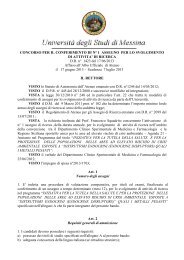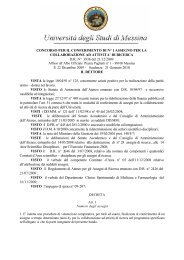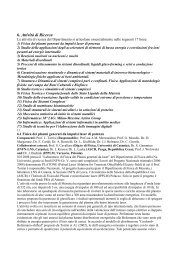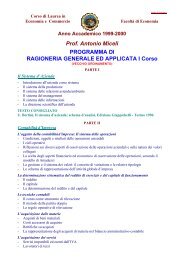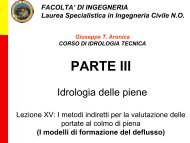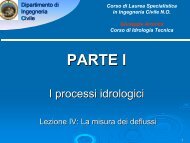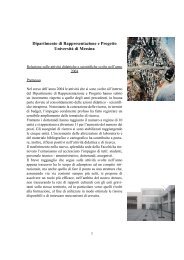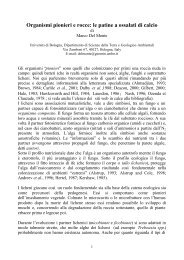PROGRAMME AND ABSTRACTS - Università degli Studi di Messina
PROGRAMME AND ABSTRACTS - Università degli Studi di Messina
PROGRAMME AND ABSTRACTS - Università degli Studi di Messina
You also want an ePaper? Increase the reach of your titles
YUMPU automatically turns print PDFs into web optimized ePapers that Google loves.
Pavel Titz, University of Pardubice, Czech Republic<br />
In<strong>di</strong>an statuette in Pompei: In<strong>di</strong>an Inkling of What?<br />
140<br />
The unique archaeological site of ancient Pompeii for two and half century attracts the<br />
attention of scholars. It offers us with extraor<strong>di</strong>nary broad and complex picture on one side and<br />
fascinating details on the other of the ancient community both material and mental life, not<br />
exclu<strong>di</strong>ng its religious attitudes. This allows us to analyze ancient Pompeians religious<br />
“tuning” on <strong>di</strong>fferent levels and in well defined contexts. Revealing of sacred structures like<br />
temples, precincts, street altars or sacred symbolism publicly <strong>di</strong>splayed is richly balanced with<br />
the assemblage of lararia placed in the shade of particular houses as well as their inner<br />
decoration in form of frescoes of mobile objects. Most of these were in use or in vogue in the<br />
moment the city <strong>di</strong>ed in AD 79. Recent excavations look also for information on the ritual<br />
praxis preserved in votive pits and their deposits. Among many beautiful objects found in<br />
Pompeii shines the ivory statuette of In<strong>di</strong>an provenience. This wonderful female nearly naked<br />
statuette excavated in 1938 was indentified with goddess Lakshmi, In<strong>di</strong>an counterpart of<br />
Roman Venus – the city of Pompeii deity. The statuette encourages the scholars to speculate of<br />
Rome`s connections with the Far East and the way it reached Campanian shores. Above this<br />
question and the subsequent idea whether the Pompeian owner of the statuette could<br />
understand or at least suspect its innermost In<strong>di</strong>an or Indo-Roman message I call into question<br />
our modern indentification. Is it correct? Is it Lakshmi?<br />
Maria Luisa Tobar, University of <strong>Messina</strong>, Italy<br />
Wed 16 th , 18.20, Classroom 6<br />
Il teatro come addottrinamento religioso: la Madonna della Lettera in Añorbe y Corregel<br />
A partire dal XVI secolo si sviluppa in Spagna un sottogenere teatrale, la come<strong>di</strong>a de santos,<br />
che ebbe una grande popolarità soprattutto nel Seicento e Settecento e che aveva come<br />
principale scopo quello <strong>di</strong> addottrinare le masse attraverso la messa in scena <strong>di</strong> storie esemplari<br />
che suscitavano devozione e inclinavano il pubblico all’esercizio della virtù. Tra le varie<br />
comme<strong>di</strong>e che si basano sulla agiografia <strong>di</strong> santi siciliani o su episo<strong>di</strong> legati al contesto<br />
siciliano, abbiamo scelto per la nostra analisi l´opera del presbitero Tomás Añorbe y Corregel<br />
il quale, nella prima metà del Settecento, scrive una trilogia dal titolo: La tutora de la Iglesia y<br />
Doctora de la Ley. La prima delle tre comme<strong>di</strong>e presenta il tema della presunta Lettera scritta<br />
da Gesù al re <strong>di</strong> Odessa Abagardo, mentre le altre due prendono spunto dalla Lettera che la<br />
Madonna avrebbe scritto ai messinesi.<br />
Pekka Tolonen, University of Turku, Finland<br />
Tue 15 th , 11.20, Classroom 6<br />
False prophets and corrupt clergy. Drawing the Boundary of Sacred in the Early Thirteenth<br />
Century Southern France<br />
800 hundred years ago, in 1209, a crusade or religious war was launched within the Western<br />
Christianity against the “infidels” in Languedoc, Southern France. After thirty years of warfare<br />
peace was concluded and nobility of Northern France established its power on the area. The<br />
first hearings of inquisition are known from the 1230s. From its scattered sources it is possible<br />
to have a perspective on the religious life of the time and place. There were <strong>di</strong>fferent religious<br />
groups living side-by-side or competing or waging war against each other. Ultimately at stake<br />
was, as it was then understood, the salvation of in<strong>di</strong>viduals and communities. The


